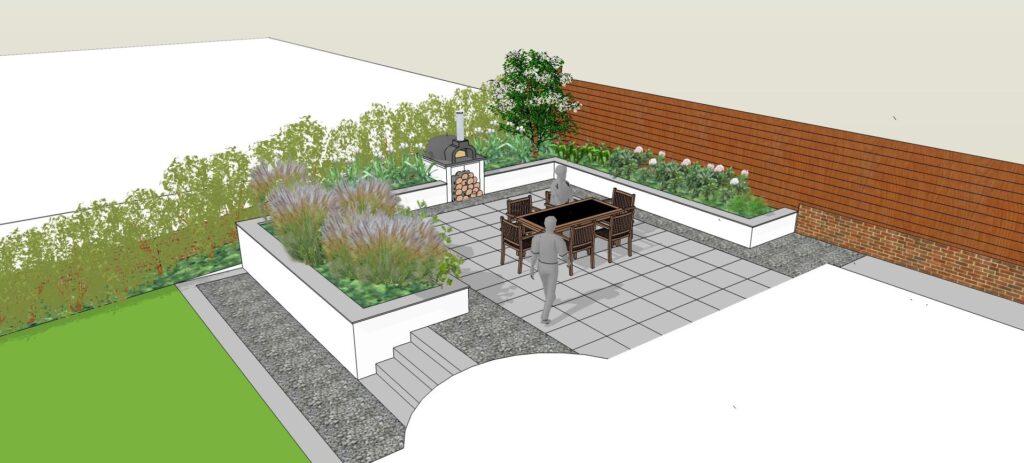
Sketchup is totally brilliant for garden design. The exciting speed you can design at, the sheer variety of resources and the beautiful 2D and 3D results all make it a very popular garden design tool. The output is realistic and accurate, making it easy for you, your clients and any other stakeholders to get a clear picture of what the finished garden’s going to look like. This article explores exactly how to design a garden border, one of the most popular traditional features in garden design that can also be taken to fresh and exciting new places using Sketchup to express your limitless imagination. Read on to find out how to do it with confidence and flair.
Designing a Garden Border
First, let’s take a look at the most important things to think about when designing a new border for a garden. The soil matters for a start, since it affects which plants will thrive in the border. While you can add nutrients to the soil it’s usually best to stick with plants that enjoy the existing conditions.
Chalky soil, for example, is well-drained and tends to be dry as a result. Clay soil sits at the other end of the scale, wet and heavy rather than dry and light. Sandy soil comes with its own challenges, as does loamy soil. All this will affect the plants you choose for the border and the way you place them within the area. That’s why borders differ so widely from garden to garden.
To pin down the best plants for the garden, think about all of the above then think again bearing sustainability in mind, a big tick for today’s garden designers in a climate change world. But plants are only one feature of a garden border. Consider the overall colour scheme. Will you major on subtle greens, from dark to pale to variegated? If you’re planting flowers will you go for a random riot of colour or pick two or three shades to focus on?
Then there’s the background. You probably won’t find yourself designing a border out of context, so think about the background as well. Is there an existing wall or fence? What height is it? Will you be enhancing the fence or wall with trellis or some other plant support system? Maybe you’ll train espalier fruit trees along the wall behind the border, perhaps you’ll paint the fence a dramatic colour to showcase the planting. Deep, rich colours like aubergine, burgundy and black, for example, make natural greens shine out beautifully.
If you need to increase, decrease or change the shape of existing borders, SketchUp is a great tool for experimenting with design ideas.
How to Design a Garden Border in SketchUp
The 3D Warehouse you get free access to with Sketchup is packed with beautiful examples of garden border design in SketchUp, and they’re great for inspiration. Take a look at this one, and this. You can download them, redesign them, move the elements around, change the dimensions, add more features and plants, and more. Because the foundation is already there it’s an easy and exciting process. So how do you design a garden border in SketchUp step by step? Let’s have a look:
- First, choose the right units, either feet or centimetres. The results will be very different so don’t get them mixed up!
- Use a variety of cool SketchUp drawing tools – the pencil, rectangle, arc and so on – to draft the overall shape of the garden border
- Find inspiring SketchUp models from the 3D warehouse to incorporate into the garden border design, things like the right kind of shrubs and plants
- Import existing models from the 3D warehouse then scale them to match the garden layout dimensions
- Move your imported 3D elements around to create the kind of garden border design you have in mind
- SketchUp lets you also design the associated garden walls and fences
- You can even use light to show where the shadows and the shaded areas they create are – this is particularly handy because once you’ve got an accurate pan of where the sun and shade falls throughout the day and through the seasons, choosing the right plants is so much easier
- You can also add in features like sheds, lawns, trees, and other exterior structures into the design easily and quickly, making the end result as accurate, attractive and easy to understand as possible – which makes getting the go-ahead from clients more of a pleasure than a potential pain
- Combined, SketchUp and the 3D Warehouse make a brilliant tool for effective garden design whatever the size, shape, and style of the land
When to Plant Your Garden Border
When thinking about designing your border, consider when to plant. The timings will feed into the garden design, giving your client different vistas and looks through the year. Ideally you’ll want to make sure there’s colour and interest in every month and through every season, so the views are always beautiful.
Depending on the time of year, different plants and flowers have their own unique needs. If you’re planning to plant in spring or summer most things will grow as soon as they’re in, while planting out in autumn or winter, when the growth slows and stops, they won’t get going until spring.
If you’re designing a garden for planting outside the growing season you can give your client two designs, one showing your idea in full bloom and leaf, and the other in winter before things have had a chance to grow. Then you can manage their expectations.
Now you know how to design a garden border in Sketchup. Did you know Sketchup comes with a huge collection of fantastic tutorials for every imaginable purpose, so the learning process is fast and fun? There’s even a free version of Sketchup Pro for you to test drive, giving you the chance to experiment. What kind of garden border will you design first?




